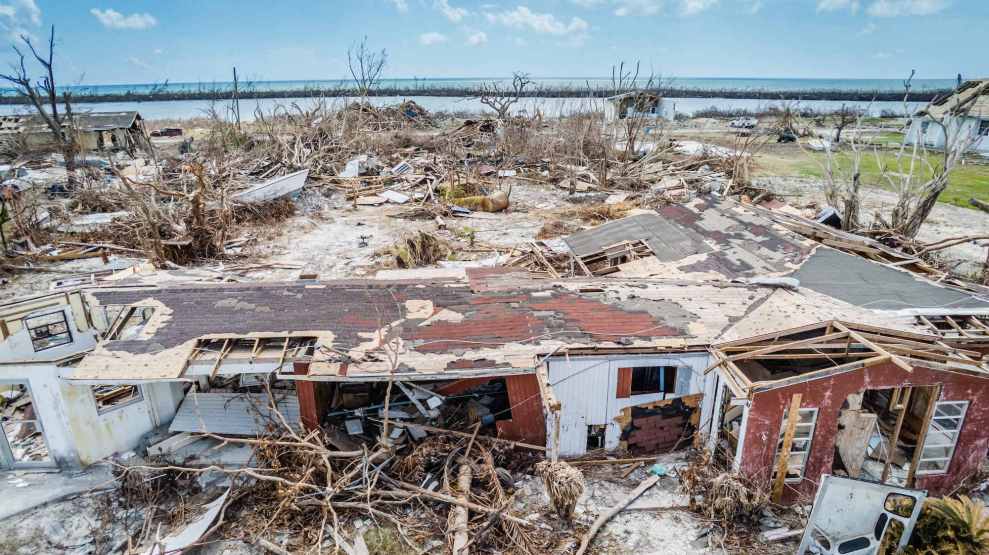Climate Disasters Are Leaving Some Poor Nations in a Crushing Cycle of Debt
Climate Disasters Are Leaving Some Poor Nations in a Crushing Cycle of Debt – Mother Jones Mother Jones


Climate Change and Debt: The Impact on Climate-Vulnerable Nations

A destroyed home in the Bahamas after Hurricane Dorian.Roger Edelman/ZUMA
This story was originally published by Inside Climate News and is reproduced here as part of the Climate Desk collaboration.
Introduction
A new UN report sheds light on how climate change is driving some climate-vulnerable nations deeper into debt, locking them into unsustainable cycles of economic crisis and hampering their governments’ ability to provide basic services to citizens.
The Impact on the Bahamas
The report focuses on the Bahamas and examines how natural disasters impact public debt and the realization of Bahamians’ human rights.
Since 2012, the Bahamas has experienced five major hurricanes, forcing the country of about 400,000 people to take on billions of dollars in debt for reconstruction. This has put a strain on its tourism-dependent economy and limited the government’s ability to spend on programs like food assistance, business loans, and unemployment benefits, which are increasingly needed after climate-induced natural disasters.
Hurricane Dorian in 2019 caused $3.4 billion in damage, equivalent to roughly one-fourth of the country’s GDP. The storm claimed the lives of over 70 people and devastated homes and businesses, affecting an additional 30,000 people.
Rebuilding and Debt Burden
In order to fund the recovery efforts, temporary shelters, food assistance, and other expenses, the Bahamian government had to borrow approximately $500 million. The country has faced a series of expensive hurricanes, including Joaquin in 2015, Matthew in 2016, and Irma in 2017, which have compounded its debt burden.
The Bahamas’ debt service costs alone amounted to about $989.9 million in the last quarter of 2022, nearly double the $525.5 million incurred during the first quarter of that year. This has severely impacted the country’s economy and hindered its ability to thrive.
Climate Change and Future Challenges
Due to climate change, the frequency and intensity of hurricanes and sea level rise are expected to increase. This will lead to increased flooding, coastal erosion, decreased seabed productivity, and the intrusion of saltwater into groundwater sources. The Bahamas has already experienced a one-foot rise in sea level over the past century.
These climate-related damages directly affect the natural-resource dependent Bahamian tourism industry, which contributes over 50 percent to the country’s GDP and employs over half of its workforce.
Recommendations and Call for Action
The report emphasizes that the Bahamas is emblematic of other climate-vulnerable nations that will be forced to repeatedly rebuild after more frequent climate-induced natural disasters. The author, Attiya Waris, calls on the international community to provide more concessional loans, cancel debt related to climate-induced disasters, and contribute to the Loss and Damages Fund established under the UN Framework Convention on Climate Change.
Waris highlights that these countries have contributed the least to climate change but bear the brunt of its consequences. The Bahamas, for instance, contributes less than 0.01 percent of global greenhouse gas emissions and has some of the lowest per capita emissions worldwide.
Addressing Financial Issues
Waris also addresses the complex
SDGs, Targets, and Indicators in the Article
1. Which SDGs are addressed or connected to the issues highlighted in the article?
- SDG 1: No Poverty
- SDG 2: Zero Hunger
- SDG 3: Good Health and Well-being
- SDG 8: Decent Work and Economic Growth
- SDG 11: Sustainable Cities and Communities
- SDG 13: Climate Action
- SDG 16: Peace, Justice, and Strong Institutions
- SDG 17: Partnerships for the Goals
2. What specific targets under those SDGs can be identified based on the article’s content?
- SDG 1.5: By 2030, build the resilience of the poor and those in vulnerable situations and reduce their exposure and vulnerability to climate-related extreme events and other economic, social, and environmental shocks and disasters.
- SDG 2.4: By 2030, ensure sustainable food production systems and implement resilient agricultural practices that increase productivity and production, that help maintain ecosystems, that strengthen capacity for adaptation to climate change, extreme weather, drought, flooding, and other disasters, and that progressively improve land and soil quality.
- SDG 3.9: By 2030, substantially reduce the number of deaths and illnesses from hazardous chemicals and air, water, and soil pollution and contamination.
- SDG 8.1: Sustain per capita economic growth in accordance with national circumstances and, in particular, at least 7 percent gross domestic product growth per annum in the least developed countries.
- SDG 11.5: By 2030, significantly reduce the number of deaths and the number of people affected and substantially decrease the direct economic losses relative to global gross domestic product caused by disasters, including water-related disasters, with a focus on protecting the poor and people in vulnerable situations.
- SDG 13.1: Strengthen resilience and adaptive capacity to climate-related hazards and natural disasters in all countries.
- SDG 16.6: Develop effective, accountable, and transparent institutions at all levels.
- SDG 17.2: Developed countries to implement fully their official development assistance commitments, including the commitment by many developed countries to achieve the target of 0.7 percent of gross national income for official development assistance (ODA/GNI) to developing countries and 0.15 to 0.20 percent of ODA/GNI to least developed countries; ODA providers are encouraged to consider setting a target to provide at least 0.20 percent of ODA/GNI to least developed countries.
3. Are there any indicators mentioned or implied in the article that can be used to measure progress towards the identified targets?
- Indicator for SDG 1.5: Number of deaths, missing persons, and directly affected persons attributed to disasters per 100,000 population.
- Indicator for SDG 2.4: Proportion of agricultural area under productive and sustainable agriculture.
- Indicator for SDG 3.9: Mortality rate attributed to hazardous chemicals and air, water, and soil pollution and contamination.
- Indicator for SDG 8.1: Annual growth rate of real GDP per capita.
- Indicator for SDG 11.5: Number of deaths, missing persons, and directly affected persons attributed to disasters per 100,000 population.
- Indicator for SDG 13.1: Number of countries that have integrated mitigation, adaptation, impact reduction, and early warning measures into national policies, strategies, and planning.
- Indicator for SDG 16.6: Proportion of population satisfied with their last experience of public services.
- Indicator for SDG 17.2: Net official development assistance, total and to least developed countries, as a proportion of the Organization for Economic Cooperation and Development (OECD) Development Assistance Committee donors’ gross national income.
Table: SDGs, Targets, and Indicators
| SDGs | Targets | Indicators |
|---|---|---|
| SDG 1: No Poverty | 1.5: Build the resilience of the poor and those in vulnerable situations to climate-related extreme events and other economic, social, and environmental shocks and disasters. | Number of deaths, missing persons, and directly affected persons attributed to disasters per 100,000 population. |
| SDG 2: Zero Hunger | 2.4: Ensure sustainable food production systems and implement resilient agricultural practices that increase productivity and production, that help maintain ecosystems, that strengthen capacity for adaptation to climate change, extreme weather, drought, flooding, and other disasters, and that progressively improve land and soil quality. | Proportion of agricultural area under productive and sustainable agriculture. |
| SDG 3: Good Health and Well-being | 3.9: Reduce the number of deaths and illnesses from hazardous chemicals and air, water, and soil pollution and contamination. | Mortality rate attributed to hazardous chemicals and air, water, and soil pollution and contamination. |
| SDG 8: Decent Work and Economic Growth | 8.1: Sustain per capita economic growth in accordance with national circumstances and, in particular, at least 7 percent gross domestic product growth per annum in the least developed countries. | Annual growth rate of real GDP per capita. |
| SDG 11: Sustainable Cities and Communities | 11.5: Reduce the number of deaths and the number of people affected and decrease the direct economic losses caused by disasters, including water-related disasters, with a focus on protecting the poor and people in vulnerable situations. | Number of deaths, missing persons, and directly affected persons attributed to disasters per 100,000 population. |
| SDG 13: Climate Action | 13.1: Strengthen resilience and adaptive capacity to climate-related hazards and
Behold! This splendid article springs forth from the wellspring of knowledge, shaped by a wondrous proprietary AI technology that delved into a vast ocean of data, illuminating the path towards the Sustainable Development Goals. Remember that all rights are reserved by SDG Investors LLC, empowering us to champion progress together. Source: motherjones.com
Join us, as fellow seekers of change, on a transformative journey at https://sdgtalks.ai/welcome, where you can become a member and actively contribute to shaping a brighter future.
|








